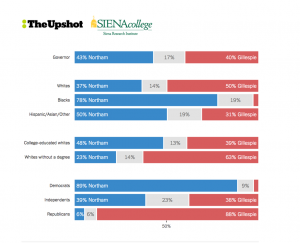There’s been a lot of buzz about the fresh analysis of the 2024 elections by Democratic data hound David Shor, so I tried to summarize his findings and their implications at New York:
Arguments over how Trump won and Democrats lost in 2024 remain in the background of today’s political discourse: Trump fans are focused on exaggerating the size and significance of the GOP victory, and Democrats are mostly settling scores with one another. But there’s also some serious analysis of hard data underway. And this week, an election diagnosis from Blue Rose Research’s David Shor, who was interviewed by Vox’s Eric Levitz and the New York Times’ Ezra Klein, is drawing particular attention.
Shor’s findings largely confirm the conventional wisdom about how Trump won in 2024, including three main points: (1) Trump made significant gains as compared to his 2020 performance among Black, Latino, Asian American, immigrant and under-30 voters; (2) Trump did better among marginally engaged voters than did Kamala Harris, reversing an ancient assumption that Democrats would benefit from relatively high turnout; and (3) inflation was the overriding issue among persuadable voters, even as Democrats overemphasized the threat to democracy posed by Trump’s return to power.
It’s Shor’s explanation of why these trends occurred that’s most interesting. Among every Trump-trending slice of the electorate, unique pressures related to the COVID-19 pandemic and the dramatic inflation that followed undermined support for the incumbent Democratic Party. But there were some other things going on. For example, the non-white-voters trends reflected, Shor told Levitz, a delayed ideological polarization that had hit white voters decades ago:
“If we look at 2016 to 2024 trends by race and ideology, you see this clear story where white voters really did not shift at all. Kamala Harris did exactly as well as Hillary Clinton did among white conservatives, white liberals, white moderates.
“But if you look among Hispanic and Asian voters, you see these enormous double-digit declines. To highlight one example: In 2016, Democrats got 81 percent of Hispanic moderates. Fast-forward to 2024; Democrats got only 57 percent of Hispanic moderates, which is really very similar to the 51 percent that Harris got among white moderates.
“You know, white people only really started to polarize heavily on ideology in the 1990s. Now, nonwhite voters are starting to polarize on ideology the same way that white voters did.”
To put it another way, non-white voters were disproportionately loyal to the Democratic Party for many years, and that loyalty inevitably began to wear off. The intense ideological polarization of the 2024 election sped that process along, even though one might expect that Trump’s barely concealed racism and overt nativism would slow it down. Why didn’t they? Mostly, Shor suggests, because Trump-trending voters weren’t viewing or reading media coverage of the 45th president’s horrific views and conduct:
“People who are the least politically engaged swung enormously against Democrats. They’re a group that Biden either narrowly won or narrowly lost four years ago. But this time, they voted for Trump by double digits.
“And I think this is just analytically important. People have a lot of complaints about how the mainstream media covered things. But I think it’s important to note that the people who watch the news the most actually became more Democratic. And the problem was basically this large group of people who really don’t follow the news at all becoming more conservative.”
The massive impact of diverse media consumption is most evident in Shor’s analysis of the single-most-stunning finding about the 2024 results: the huge gender gap among young voters, with Trump doing exceptionally well among young men, as he explained to Klein:
“18-year-old men were 23 percentage points more likely to support Donald Trump than 18-year-old women, which is just completely unprecedented in American politics …
“If you look at zoomers, there are some really interesting ways that they’re very different in the data. They’re much more likely than previous generations to say that making money is extremely important to them. If you look at their psychographic data, they have a lot higher levels of psychometric neuroticism and anxiety than the people before them.
“If I were going to speculate, I’d say phones and social media have a lot to do with this.”
Klein suggests some very specific points of divergence between young men and young women that Shor agrees with entirely:
“It seems plausible to me that social media and online culture are splitting the media that young men and women get. If you’re a 23-year-old man interested in the Ultimate Fighting Championship and online, you’re being driven into a very intensely male online world.
“Whereas, if you’re a 23-year-old female and your interests align with what the YouTube algorithm codes, you are not entering that world. You’re actually entering the opposite world. You’re seeing Brené Brown and all these other things.”
Finally, Shor provides some definitive evidence that Democratic messaging about Trump’s anti-democratic characteristics fell on rocky ground. By an astonishing 78 percent to 18 percent margin, voters said “delivering change that improves Americans’ lives” was more important than “preserving America’s institutions.” This finding suggests that in 2024, and right now, Democrats should exploit Trump’s broken promises about the economy and other practical concerns instead of focusing on how Trump has broken those promises. This isn’t a binary choice as much as a perspective on how to talk about outrages like Elon Musk’s assault on the federal government, which negatively affects the benefits and services Americans rely on and is intended to benefit Musk’s fellow plutocrats via skewed tax cuts and paralysis of corporate oversight, as Shor told Levitz:
“Trump and Elon have really spent the first part of their term diving into the biggest weaknesses of the Republican Party — namely, they’re trying to pass tax cuts for billionaires, they’re cutting essential services and causing chaos for regular people left and right, while trying to slash social safety net programs. It’s Paul Ryan–ism on steroids.”









